|
Therizinosaurs |
|
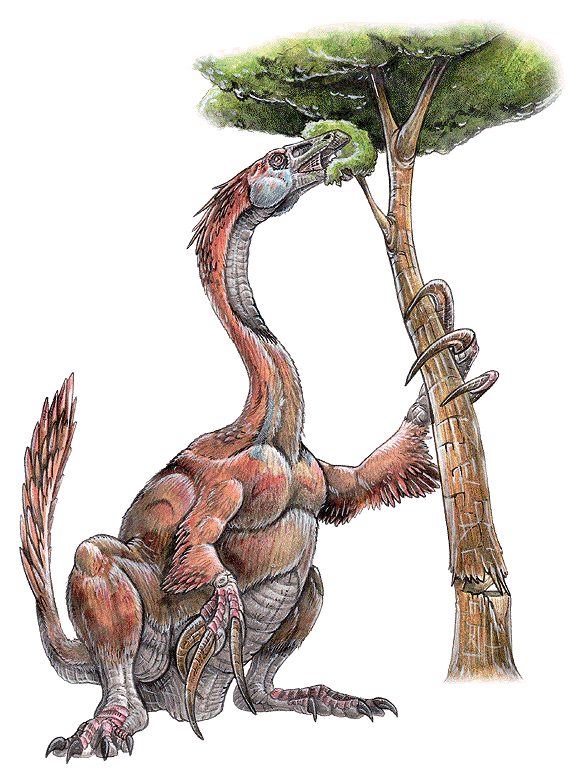 |
|
This group of dinosaurs evolved
from swift predators into lazy herbivores.
The revision will show the above image of Therizinosaurus
cheloniformis. |
Therizinosaurs are the
strangest dinosaurs ever discovered. These are incredibly weird
animals that baffled paleontologists for many years. The first
record of their existence was the 1948 discovery of giant 3-foot
long claws that certainly did not below to any known species. Maleev thought they may have come from an
otherwise unknown giant chelonian (turtle). In 1954, he
named it Therizinosaurus cheloniformis.
Around ten years later another giant Therizinosaur claw was found,
but this time along with other fossils, including a tooth, parts
of the front and rear limbs and even a four-toed foot. The
forelimbs had all the characteristics of the fierce meat-eating
theropods, such as tyrannosaurs and velociraptors, but they were
much longer than any known species. The pelvic bones were thought
to belong |
 |
|
late survivor descendents of early
Mesozoic prosauropods. Displaying a mix of
characters from across
Dinosauria. Therizinosaursus skeletons look as if they were
assembled by a drunken designer who got quite confused as to what
belonged where.
More Therizinosaurus fossils were found in the late 1970s.
There was enough difference between them and the earlier fossils to
determine that they were from a different, but very closely related,
species. The partial specimen was named Erlikosaurus. The
limbs established that it was a theropod. More importantly, it
yielded the full full skull of any therizinosaur. It was the
massive skull with powerful jaws and sharp, blade-like teeth found on
other theropods. Erlikosaurus had a small skull, but the big surprise
was that it had small peg-like teeth and the anterior part of the
muzzle was modified into a toothless, bill-like structure similar to a
bird's beak.
The 1994 discovery of Alxasaurus helped to solve many of the
mysteries because it was the most complete Therizinosaurus
found to date. Taken together, the three species provided enough
material to reconstruct this strange group of animals. Except for the basal form
Beipiaosaurus inexpectus,
they were large, heavily built creatures that were probably quite
slow. Their pelvis was perfectly shaped for sitting, the same
way a ground sloth sits when feeding from trees. Another hint as
to a sitting way of life, lies in the dorsal vertebrae, as they are
tall, and built for keeping a big animal vertically - most probable
sitting. The bird-like beak and lack of teeth were unsuitable
for a meat-eater, which meant that Therizinosaurus was a herbivore.
They had long arms with enormous
claws on their manus (hands); some were up to 3 feet long. These provided an excellent tool to strip
vegetation from trees and bring it into the mouth. They would
have also provided defense against predators, as running away was not
an option. It has been suggested that
they used these giant claws to strip leaves from trees. If
Therizinosaurs were plant-eaters, then they are the only such critters
classified with the fierce, meat-eating theropods.
The four specimens shown below cover the evolution of these strange
animals over 30 million years. As they grew in size, they become
slow and lazy, evolving from predators into herbivores. They are
the only herbaceous theropods.
The proverbial icing on the cake was the 1999 discovery of
Beipiaosaurus, as it was covered with feathers, the longest
feathers found on any dinosaur to date. By extension, it is
believed that all of its closely-related cousins had them too.
What emerges is a really strange dinosaur - a herbivore theropod that
looked somewhat like a giant goose and probably ate and behaved
somewhat like the now-extinct ground sloth. |
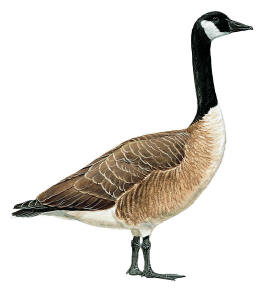 |
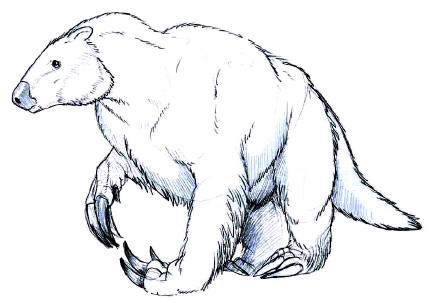 |
| Canadian Goose -
Branta canadensis |
Giant Extinct Sloth
- Megatherium |
|
|
T
herizinosauridae fossils have
been found in Early through Late Cretaceous
deposits in
Mongolia, the People's Republic of China and Western North
America. Various features of the forelimbs, skull, and pelvis,
unite them quite comfortably, both as probable theropods and, as
Maniraptora, close relatives to birds. These strange creatures were are bipedal,
and have hands bearing three fingers each. Their bodies have radically
changed to accommodate their vegetarian lifestyle. The hips of a therezinosaur are much wider then is normal for a maniraptor, and the
pubis is swept backward in the manner of a bird or ornithischian
dinosaur, to make room the large belly needed to digest plant matter.
Because of its tremendous gut, the center of balance of a
therezinosaur is shifted backward along its spine, and these creatures
squat like sumo wrestlers, with their torsos held further up then is
normal for a maniraptor. To make matters even more confusing, the
tiny, non-functional hallux claw possessed by most maniraptors has, in
the therizinosaurs, been greatly enlarged to make a decidedly un-maniraptorian
four-toed foot. Misfits even in the varied and bizarre clade
Maniraptora, and in the face of stiff competition from the
hadrosaurs,
ceratopsians, and other ornithischian herbivores, the
therizinosaurs have nonetheless flourished in the past 130 million
years, and have spread themselves across Eurasia and the Americas.
Eggs attributed to therizinosaurs are found from Cretaceous sediments
of Mongolia.
Therizinosaur eggs sometimes enclose embryos. Two main types of embryo
have been found.
The history of Therizinosauria begins in the early Cretaceous, when
small browsers like Beipiaosaurus lived in the lush forests of
Asia. By the end of the Mesozoic, the therizinosaurs had expanded far
into their herbivorous life-style, evolving into huge, lumbering forms
like Segnosaurus and Therizinosaurus, itself. |
|
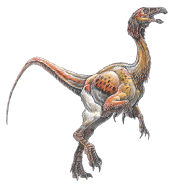 |
Falcarius utahensis - 125 MYA
Found in Utah, USA
This newly discovered species appears to be the missing link
between early carnivores and herbaceous Therizinosaurs. First
of its kind found outside of Asia.
|
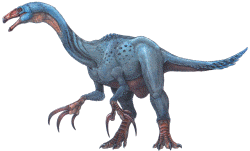 |
Beipiaosaurus inexpectatus - 130 MYA
Found in Liaoning, China. 7 ft long. Carnivore.
Described in 1999, its fossils include the largest feathers found
on any dinosaur. |
 |
Alxasaurus elesitaiensis - 112 MYA
Found in Mongolia, China. 13 feet long. Carnivore.
Most complete fossil specimen found in Asia.
|
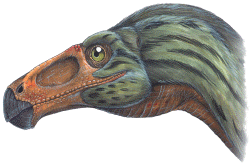 |
Erlikosaurus andrewsi
- 95 MYA
Found in Mongolia, China. 20 feet long. Herbivore?
The only therizinosaur with a fully known skull (at least
prior to the recent discovery of Falcarius utahensis.
See: Discoveries |
 |
Therizinosaurus cheloniformis
- 77-71 MYA
Mongolia, China. 26 feet long. Herbivore.
Its enormous claws were discovered in 1948. They were
so unique that it was obviously a new species. It was named
in 1954. A few years later more fossils were found that
provided a rough pictures of its appearance, but additional finds
in the 1980's helped to fill in the details |
| |
Other described species |
| |
Chilantaisaurs zheziangensis
(Dong, 1979)
Time: Late Cretaceous. Place: Mongolia. Size: unknown
Remains: Claws This species has been classified under "Segnosaurus"
zheziangensis and might really be any Mongolian therizinosaur that fits it's
size. |
| |
Enigmosaurus
mongoliensis (Barsbold & Perle, 1983)
Time: Cenomanian - Late Cretaceous, 93-89 MYA
Place: Mongolia
Length: 6 meters. Fossil consists of partial hip. It
may be the pelvis of Erlikosaurus.
The Pubic boot is shaped much sharper than the one of
Segnosaurus,
and so is the ischium, which is totally fused to the pubis, making
it
one single pelvic bone. |
| |
Eshanosaurus deguchiianus
(Xu, Zhao & Clark, 2001)
Time: Early Jurassic, 200 MYA. Place: China
Size: ca 1m. (if therizinosaur) or 1,5-2m (if prosauropod)
Remains: Mandible. Thought to be a Therizinosaur due to the
mandible shape,
but the time it lived, points to that it may really have been a
Prosauropod
of some kind. There's still debate going on about this. |
| |
Segnosaurus galbinensis
(Perle, 1979).
Segnosaurus (meaning "slow lizard") was a meat-eating dinosaur
that lived during the late Cretaceous period, about 97.5 to 88.3
million years ago. Segnosaurus walked on two long legs, a long
flexible neck, long head, three-toed feet, a short body, a long
tail, long, strong legs, and clawed fingers and toes. Segnosaurus
was perhaps 13 to 30 feet (4-9 m) long; its size is uncertain.
Unlike other therizionsaurs, It appears to have been a carnivore
that ate small animals, like insects. Three partial skeletons have
been found in Mongolia. |
| |
Nanshiungosaurus brevispinus
(Dong, 1979)
Time: Campanian, Senonian, Late Cretaceous, 71 MYA
Place: China. Size: 4m. Remains: Complete cervical/dorsal vertebral column,
incomplete pelvis. This is the only therizinosaur with cervical ribs shrinked to small bumps
and fused to the cervical vertebrae. The neck was robust, and so
was the dorsal column.
The pubis is only known by a little bony knob, but was probably
similar to the one of
Segnosaurus, while the ischium was much broader, and
spoonshaped. The ilium
is much taller as well. The downward turning of the preacetabular
process in this
species goes to the extreme, but they are about the same as in
Segnosaurus when seen from above. |
| |
Nashiungosaurus |
| |
Neimongosaurus
(Zhang, Xu, Sereno, Kuang & Tang, 2001)
Time: Late Cretaceous
Place: China
Size: ca 2m.
Remains: (to be updated)
Notes: This species is a bit difficult to classify, as it's
got more
cervical vertebrae than both Alxasaurus and
Nanshoungosaurus.
At the same time, it's pelvis is fairly fragmental, and cannot be
used to
classify much. It is almost entirely the vertebral structures,
the length
of the tail, the mandibular fragment and the general structure of
the animal
that helps put a diagnosis on this species. |
| |
Nothronychus mckinleyi (Kirkland & Wolfe vide Stanley, 2001)
pronounced "no-thron-EYE-kus"
Time: Late Cretaceous, 89 MYA
Place: New Mexico, Utah, USA.
Size: 4,5-6m.
Discovered in 2001,
It was the first therizinosaurs
found in the Americas. The others all came from China and
Mongolia. Nothronychus apparently evolved into a
plant-eater, said Jim Kirkland, a paleontologist with the Utah
Geological Survey. No fossil evidence was found of feathers,
but Wolfe noted that similar dinosaurs from Asia were found with
feathers and speculated that this one had "a loose gaggle of
feathers around the head and along the spine, back of the arms and
legs." |
| |
Segnosaurus galbinensis (Perle, 1979)
Time: Late Cretaceous, 93-89 MYA.
Place: Mongolia
Size: 4-9m. Remains: Mandible, pelvis
girdle, spine
fragments, metatarsals, phalanges, partial scapula, coracoid,
humerus, tibia,
fibula, complete pelvis.
Notes: The few remains of this species indicate low, broad pes and a wide
pelvis, the same features as Alxasaurus, only more
prominent. The pubis
is clearly backwards pointing, and the ischium is in direct
contact with the pubis.
The lower jaw has a strong downwards bend in it, and got tall
peg-like teeth. |
|
|
|
|
|
|
|
|
Edugraphics.Net | Feenixx Publishing |
|
|
|
|
|
![]()








